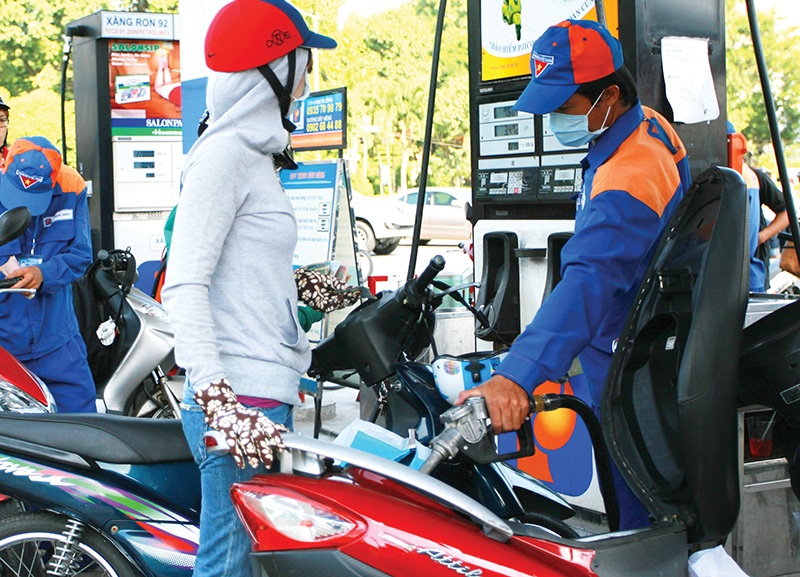Gas and oil hikes put strain on businesses
 |
| Consumers have noticed a hefty rise in petrol prices in recent weeks, photo Le Toan |
Hanoian housewife Minh Ngoc is worried about the dramatic price increases in recent weeks. “I bought a gas tank for over VND500,000 ($21.75), which is VND120,000 ($5.20) more than last month. Gas, cooking oil, and vegetables all have become more expensive recently,” Ngoc said. “The sellers said that the hike in petroleum prices is the cause. So, I had kept a lid on my spending, also because my income decreased amid social distancing.”
Taxi driver Trung Duc is also concerned about his company’s adjustment on fares due to the change in petroleum prices, which could also bring a decline in customers. “The fares increased to an average of VND17,000 (74 US cents) per km for a seven-seater and VND15,000 per km (65 US cents) for a five-seater, which makes it difficult to compete with other taxi brands and ride-hailing services. We are concerned that passengers will not book our taxis anymore if this continues,” Duc said.
Besides Ngoc and Duc, many manufacturers are suffering pressure under the increase of material prices for their production. Many products, such as cement and steel, have seen price hikes recently.
Since the beginning of this year, the Ministry of Industry and Trade and the Ministry of Finance (MoF) adjusted selling prices of petroleum and oil 18 times to be more suitable with the world’s markets. In September, the average price of both oil and petroleum increased by 24.1 per cent on-year.
Fuel prices increased by 40–53 per cent in the first 10 months of this year. The latest increase brought the most-used RON 95 to VND24,330 ($1.07) per litre, the highest since September 2014.
Assoc. Prof. Dr. Ngo Tri Long, former head of the Price and Market Research Institute under the MoF, told VIR, “Price increases for petroleum and oil will make Vietnam enjoy the benefits from exporting crude oil. However, the disadvantage is that business activities of people and enterprises will suffer. Thus, the hikes in these products will not only impact on household spending but also cause pressure on manufacturers, who have been already weakened during the pandemic.”
Statistics published by the General Statistics Office (GSO) showed that Vietnam’s imported materials make up 37 per cent in the total cost for materials of the whole country. The expenditures for petroleum and oil account for 3.52 per cent of the whole economy’s production cost. Thus, the increase in costs of these products on the world market will push the selling price of both imported and domestic materials.
According to Nguyen Bich Lam, former director-general of the GSO, along with the direct impact on product costs, the increase in gasoline prices also raises the prices of other goods in circulation and puts pressure on inflation, while reducing the competitiveness of domestically produced goods and negatively impacting economic growth.
Lam said that in Vietnam, when the price of petroleum and oil increases by 10 per cent, the GDP will decline by 0.5 per cent, and the consumer price index will increase by 0.36 percentage points.
According to Goldman Sachs’ forecast, the year-end Brent crude oil prices would rise to $90 per barrel from $80 now, as fuel demand is expected to recover fast. Oil prices could stay at higher levels in the years to come as demand rebounds while supply remains tight. The market fundamentals warrant higher prices and the bank’s forecast for Brent crude is an average of $85 per barrel for the next several years.
Responding to the forecast, Long said, “The consecutive increase in oil prices on the world market will be dangerous for GDP because it will push the prices of animal feed. As a result, the selling prices for food will also climb to a higher level.”
According to the expert, to limit the impact of the growth momentum on these products, the government should regulate a price stabilisation fund and apply tariffs and fees.
“The price stabilisation fund is exhausted, thus the only solution is the adjustment of tariffs and fees, which make up 42 and 43 per cent of the prices of gasoline, respectively,” Long said.
“Furthermore, the domestic petroleum and oil market has yet to become competitive, which is dominated by groups such as PetroVietnam, and PVI Oil. These units hold the right to self-determinate selling prices of gasoline. Thus, the state has to remove this right to balance the market.” Long said.
What the stars mean:
★ Poor ★ ★ Promising ★★★ Good ★★★★ Very good ★★★★★ Exceptional
Related Contents
Latest News
More News
- First members of Danang International Finance Centre revealed (December 22, 2025 | 17:39)
- Human-centred governance seen as key to AI development (December 19, 2025 | 18:19)
- Top 10 notable events of Vietnam’s industry and trade sector in 2025 (December 19, 2025 | 14:00)
- Tungsten surges to 12-year high as world enters a new 'black gold' race (December 18, 2025 | 17:27)
- Vietnam’s coffee exports set new record despite price pressures (December 18, 2025 | 17:13)
- Garment and textile sector seeks new growth after volatile year (December 18, 2025 | 17:01)
- VinSpeed and Siemens strengthen cooperation for high-speed rail development (December 18, 2025 | 16:53)
- High-tech adoption for TH true MILK (December 18, 2025 | 13:39)
- Takeda supports health resilience amid climate change challenges (December 18, 2025 | 12:39)
- Mondelez Kinh Do - a chapter of purpose-led leadership in Vietnam (December 18, 2025 | 09:44)

 Tag:
Tag:






















 Mobile Version
Mobile Version